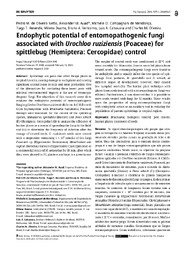Endophytic potential of entomopathogenic fungi associated with Urochloa ruziziensis (Poaceae) for spittlebug (Hemiptera: Cercopidae) control.
Endophytic potential of entomopathogenic fungi associated with Urochloa ruziziensis (Poaceae) for spittlebug (Hemiptera: Cercopidae) control.
Author(s): NETTO, P. M. de O.; AUAD, A. M.; MENDONÇA, M. O. C. de; RESENDE, T. T.; DUARTE, M.; VERÍSSIMO, B. A.; CALSAVARA, L. A.; OLIVEIRA, C. M. de
Summary: Spittlebugs are pests that affect forage plants in tropical America, causing damage to such plants and causing significant annual losses in milk and meat production. One of the alternatives for combating these insect pests with minimal environmental impacts is the use of entomopathogenic fungi. The objectives of this research were: (i) to evaluate the endophytic potential of entomopathogenic fungi applied to Urochloa ruziziensis (R.Germ. & C.M.Evrard) Crins (synonymous with Brachiaria ruziziensis; Poaceae) through seed treatment for the control of the spittlebug species, Mahanarva spectabilis (Distant) and Deois schach (F.) (Hemiptera: Cercopidae); (ii) to analyze the efficiency of banker plants as a means of spreading the fungi to the field; and (iii) to determine the frequency of infection after the storage of treated seeds. U. ruziziensis seeds were treated with a suspension containing 1 × 108 conidia of the fungi Fusarium sp. (Hypocreales: Nectriaceae), Metarhizium anisopliae (Metschn.) Sorok?n (Hypocreales: Clavicipitaceae) or a commercial strain of M. anisopliae for 30 min, after which they were planted in 2 L planters and kept in a greenhouse. The surplus of treated seeds was conditioned at 22 °C and sown monthly for 10 months. Insects were fed plants from treated seeds. The entomopathogenic fungi were found to be endophytic and to equally infect the two species of spittlebugs from pastures, M. spectabilis and D. schach, at different stages of development; however, they caused low nymphal mortality. The banker plant technique with plants from seeds treated with entomopathogenic fungi was efficient. Furthermore, it was observed that it is possible to store seeds treated with fungi for 12 months. These results open the perspective of using entomopathogenic fungi with endophytic action as an auxiliary tool in reducing the populations of pasture spittlebugs in tropical regions.
Publication year: 2024
Types of publication: Journal article
Unit: Embrapa Dairy Cattle
Observation
Some of Embrapa's publications are published as ePub files. To read them, use or download one of the following free software options to your computer or mobile device. Android: Google Play Books; IOS: iBooks; Windows and Linux: Calibre.
Access other publications
Access the Agricultural Research Database (BDPA) to consult Embrapa's full library collection and records.
Visit Embrapa Bookstore to purchase books and other publications sold by Embrapa.

